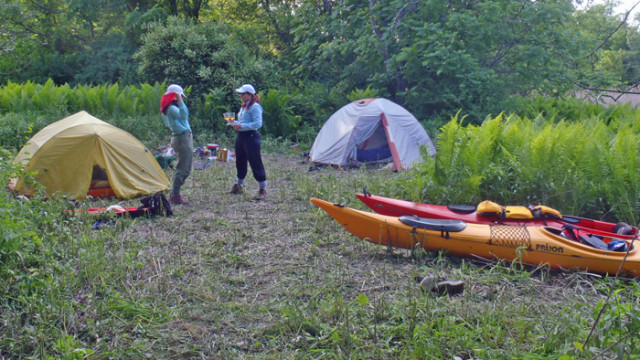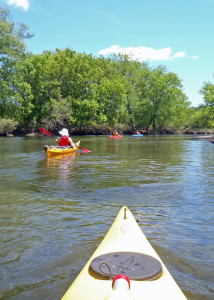
This same week in June last year, I told you about a 29-hour backpacking getaway that my sweetheart Marilyn and I took with our friends Susan and David. In the middle of blackfly season (very few other people around), we hiked into the Sawyer Pond in New Hampshire’s White Mountain National Forest, and came out the next day completely renewed.
This year, we went kayak camping on the Connecticut River. Our total trip time was 28 hours, door to door. We used less than a tank of very expensive gas, the food we ate came from our freezer and pantry and, since we already own all the gear we needed, our kayaks, tents, sleeping systems, stove, etc., actually got incrementally cheaper per use.
Overnight getaways are easy with a little practice and David and I practice as often as we can. We’ve even published a basic backpacking checklist that works for overnights or longer trips whether you cary your gear in a backpack or a kayak . . .
Susan and David arrived at our house after work on Friday night with two kayaks and their own camping gear ready to go. Our car was already packed, too. Being a little organized meant that, on Saturday morning, we could linger over coffee at home and still arrive at the Fairlee Diner in Fairlee, Vermont (one of our favorite breakfast spots) in time for a huge late breakfast (a bit of advice: don’t let the name of the “Garbage Omelet” dissuade you from trying one!). This is just across the bridge from our takeout point in Orford, NH, which we initially found on the list of boat access points maintained by the New Hampshire Fish and Game Department.
We first drove both cars to our launching spot at Bugbee Landing on the Waits River in Bradford, Vermont (off Doe Meadow Lane). This launch has a lovely little canoe/kayak-camp site right there, maintained by the local elementary school. We unloaded both cars, then David and I sorted gear, stuffed it into dry bags and stowed it in the watertight hatches on the kayaks, while Marilyn and Susan shuttled one car back to our takeout point (previously marked on a GPS). By the time they got back, we were ready to paddle. We pushed off from the dock and paddled down the Waits River, under a railroad bridge, barely squeaking across a shallow sandbar (the channel seems to have filled in almost all the way across) then joined the broad Connecticut, heading generally south with the current.
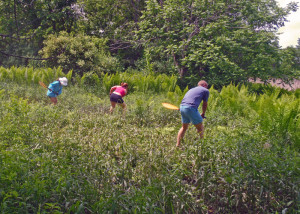
Though the river was fairly high and silty, the current was smooth and gentle. The paddling was easy and, within an hour after launching, we were at our campsite on a private island. David owns a share of this land and he and I had camped here before. But that was earlier in the season, and we weren’t quite prepared for the lush, dense jungle of vegetation that greeted us in early June. Head-high ferns and weeds everywhere . . .
Rising to the challenge, we quickly discovered that half of a sturdy, two-piece AquaBound kayak paddle makes a very serviceable weedwhacker (one very good argument for durable plastic blades) and a half hour after landing we had space cleared for two tents and a “kitchen” area. Shortly after that, the tents were set, the kitchen organized and we were back on the water paddling, exploring and fishing. It was Free Fishing Day in New Hampshire, no license required (note for next year: this event usually happens the first Saturday in June).
While out, we stopped at a clear inlet stream (the river was very silty) to get water for the night and next morning. We filtered our drinking/cooking water through a Platypus Gravity Works Filter system from Platypus. We could have brought our water with us in the kayaks, but this Platypus system is easy and effective, and treats large volumes of water quickly with no pumping required. It’s a great piece of gear for kayak camping or group backpacking.
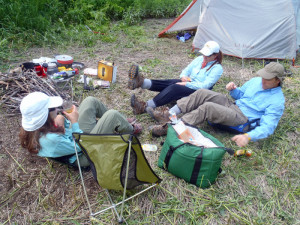
Back at the campsite, we kicked back, sipped good wine (a tradition for us) and feasted on appetizers until the grilled spareribs were done. We then spent the rest of the long summer evening sitting, talking and laughing while being serenaded by a host of birds. Trust me, this whole experience was MUCH better than being home in front of the TV!
We were in our sleeping bags by the time it got fully dark, slept soundly in the silence (Marilyn said it was the best night’s sleep she’s had in months), and awoke to more bird calls in the pre-dawn light .
Breakfast and packing up took a couple of leisurely hours, then we were back on the river for a beautiful 8-mile paddle to our takeout before a rising upstream wind made paddling an effort. The Connecticut river is especially beautiful here, with lush trees and views across farm fields to rocky hills beyond.
In a tough economy with gas prices high, and free time at a premium, outdoor overnight getaways just plain make sense. With good equipment, some research and planning, overnights are a fast, easy, cheap and totally fun way to relax, recharge and refresh!
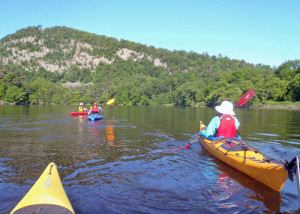
Kayak Camping On the Connecticut River: Paddle Planning
The rivers of the northeast are a tremendous (and sadly underutilized) recreational resource whether you choose to camp overnight or not. In our 12 miles on the river on a beautiful, sunny weekend, we saw only two power boats and three other kayaks.
A little research will usually turn up the launch sites you need to reach any river, and digging deeper will often find campsites as well.
One place to start is the AMC River Guides series which offer detailed descriptions of the actual paddling conditions you’ll encounter. Reading these descriptions can prevent lots of surprises.
The Connecticut River is New England’s largest river and provides a host of opportunities. The Connecticut River Paddlers Trail describes most of the access points and available primitive campsites along the river. Great resource.
The Connecticut River Watershed Council maintains a list of campsites near the river that’s far from complete but a good resource nonetheless.
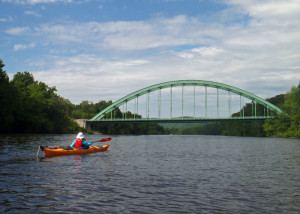
For the Connecticut River in Vermont and New Hampshire, the best place to start is the Connecticut River Joint Commission, a public/private partnership between the states of Vermont and New Hampshire and towns and private landowners along the river. They provide excellent Connecticut River boating maps free online. The Upper Valley Land Trust maintains a list of campsites along the river north of Hanover, New Hampshire.
Just Do It
The hardest canoe or kayak camping trip you’ll ever do is your first one. After that, it gets easier with practice. Pick a place, pick a day, gather your gear and go.


